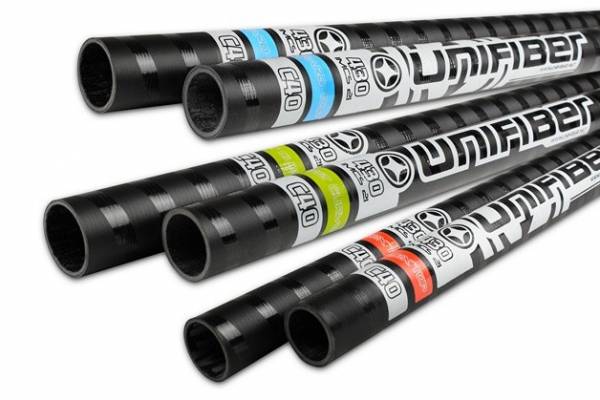The mast is a fundamental component of the windsurfing rig; it can radically change its performance. However, its importance is too often underestimated. In this article, we explain some key concepts and provide you with some usage advice.
Windsurfing masts: characteristics and technical parameters
Premise
Today, we are lucky. Those who used to go windsurfing at the dawn of the sport's history had to struggle with indivisible, and rather heavy, masts. From this point of view, masts have made giants steps, and now are light, divisible, and much more robust. Let's try to understand how they are made, and understand how the coupling with the sails works.
Construction (diameter, length and percentage of carbon)
First, today's masts are mainly divided into two categories, based on the diameter of their section: SDM masts and RDM masts.
SDM stands for Standard diameter mast. This type of masts have a longer history behind them. They have a larger diameter than the RDM ones, and today, they are used almost exclusively with large sails by those who do slalom riding. It should be noted that reference is made to the diameter at the base (48 mm, in the case of SDMs), because all the masts have a section with a diameter that decreases towards the tip.
RDM stands for Reduced diameter mast. They are masts with a reduced diameter at the base (38 mm), which have appeared on the market more recently, in particular to meet the needs of those who do waveriding, as they are sturdier masts. There are also SDS (Slim Drop Shape) masts, with an SDM section in the base of the mast which then becomes RDM in the top (upper piece of the mast).
The bending curves under stress of the SDM and RDM masts of equal length (see below) are the same, but the RDMs are more durable (greater wall thickness - see further below for the explanation), therefore more suitable to cope with the stresses of the waves impact. SDMs provide better reflex (faster response to stress), better stability and faster acceleration, and are more suitable for sailing in flat water (where stresses are less significant). Furthermore, an RDM mast for large sails would have a decidedly greater weight than an SDM.
The lengths of commercially available masts range from 340 cm up to 520 cm, with sizes spaced 30 cm apart. As mentioned, now all the masts are divisible into two pieces, top and bottom (or base), which, in the case of some brands (Ezzy, Goya, for example), can also be purchased separately. This is useful in the event of breakage of only one of the two pieces, or if, to rig a certain size of sail, a combination between a top of one size and a bottom of another is recommended (see again Ezzy and Goya).

Central part omitted. The reading of the main part of this article is reserved to Waterwind Supporters. To become a Supporter, click here.
Recent trends in masts production
Finally, it is interesting to report here what Unifiber (independent mast manufacturer) observed regarding the most recent trend of mast producers of the various sail brands. Through countless measurements, they've noticed that not all brands have stayed true to their curvature over the years. The trend in recent years is that all brands are moving towards Constant Curve masts. Some lean towards the Flex Top. The Hard Top is practically extinct.
This led Unifiber to create masts with three specific curves that perfectly match the vast majority of sail brands available today. They carefully analyzed the major manufacturers - around 80% of the market - and made the perfect masts to fit their sails. This analysis led them to divide the Flex Top category into two subcategories, in addition to the Constant Curve:
Constant Curve - This is the most commonly used curve profile (even for smaller sails).
Constant FL Curve - This is similar to the old "flex top" mast curve, but with more flex towards the bottom (around the middle) of the mast. FL = Low flexion.
Constant FH Curve - This is also similar to the old "flex top" mast curve, but there is more flex towards the top. The middle section is relatively stiff. FH = Flex High.
Note that the "old" curve classification, previously explained, is still valid. But it is no longer precise enough to identify the differences between the masts used by major brands. The result of Unifiber's analysis work, with respect to these three more specific types of curves adopted today by sail manufacturers, can be consulted by clicking here.
I hope that this detailed article is useful for clarifying ideas about masts and helps you make better choices when purchasing the best mast for your sail, so you can have more fun. If you have any questions, considerations or suggestions, please write a comment in the space provided below.
Hang loose. Fabio Muriano
Bibliography consulted:
https://www.windnews.it/wp-content/uploads/2014/02/ws-masts.pdf
https://www.maverxmasts.com/copia-di-come-armare?lang=en
https://www.unifiber.net/windsurf-masts/bend-curves
https://www.unifiber.net/windsurf-masts
https://www.unifiber.net/windsurf-masts/mast-measurement
Without your Support, Waterwind wouldn't exist. Become our supporter! If you want to advertise with us, read here, or contact us. Collaborate with us. Read here! Buy our Gadgets! Visit our YouTube channel!



